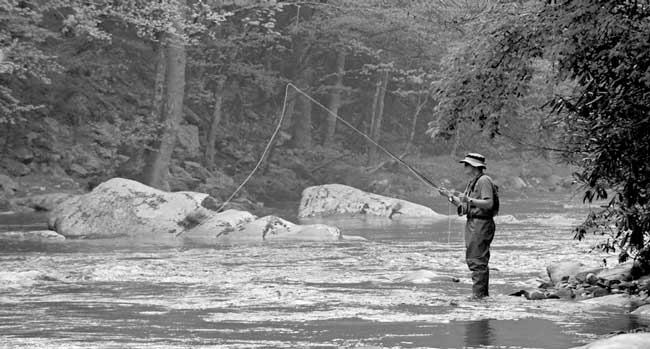
During the dog days of summer, it often pays to get up early and be on the water at or before daybreak. This especially applies to the coldwater and coolwater species such as trout and smallmouth bass, fish that become lethargic and don’t usually feed during the hottest hours of the day.
One of my favorite techniques for catching trout and smallmouth bass on early summer is to use a fly rod and big bushy nymphs in moving water. If fortunate enough, rivers such as the Chattooga and the Chauga here in South Carolina offer the opportunity to catch both species on successive casts.
While fly fishing with nymphs essentially requires the same gear you use when fishing dry flies or bass bugs, there are a few small items that any successful nymph fisherman will want to have.
To be successful, it’s necessary to fish the nymph deep in the water column without getting hung up on the bottom. A strike indicator, in addition to signaling when a fish has taken the fly, suspends the nymph and weight to any depth you desire.
Strike indicators are attached to the leader well above the fly — or on the fly line itself — and float on the water’s surface. The distance between the fly and the indicator should usually be 1½ times the depth of the water you are fishing. If the current is particularly heavy, a longer leader will be necessary to get the nymph near the bottom.
Strike indicators are very similar to bobbers, although most fly fishermen would never admit it. They help the angler visually see what the nymph is doing below the surface. When a fish takes the nymph, the indicator will be pulled under, will hesitate in the current, or will move sideways. With practice and patience, you’ll eventually learn when these unnatural movements occur to the strike indicator and when a fish has taken the fly.
A fish will take a nymph, realize it’s not food, and spit it back out in a matter of milliseconds. The strike indicator helps signal the take so that the angler can set the hook without any delay.
The second thing you’ll need while nymph fishing will be some small weights to add to your fly line or leader. For line control and ease-of-use, a floating fly line is preferable to a sinking line for nymph fishing. So the only way to get the nymph down to the river bottom is using small weights or split shot.
Using these weights, an angler can put on as much or as little weight as needed to bring the fly down to the necessary depth. Weights made of a non-toxic material, opposed to the old lead variety, are much more friendly to the environment.
In very deep or fast rivers, where even a weighted leader will not get the fly down to the necessary depth fast enough, a sink-tip line might be the ticket. With a sink-tip line, the angler does sacrifice the ability to control the line and detect strikes, but it will get deep very quickly.
One more item of importance for nymph fishermen is a good pair of polarized sunglasses. The angler needs to easily see the strike indicator, and polarized sunglasses help by eliminating glare from the water’s surface.
By being able to see into the water, the angler can also see potential snags, rocks, and likely holding spots for fish. When a fish takes a nymph, it will often turn slightly sideways, revealing a flash of brilliant underbelly. This often is a visual trigger for the angler to set the hook, even if the line or indicator doesn’t move. Polarized sunglasses are essential for the ability to see what is happening below the surface.
For early mornings during the hot summer months, nothing beats a big, black stonefly nymph fished near the bottom. I have personally caught both big trout and smallmouth using this technique. Once the sun has been up for a few hours, its time to pack it in and find a cool place to spend the rest of the day.



Be the first to comment